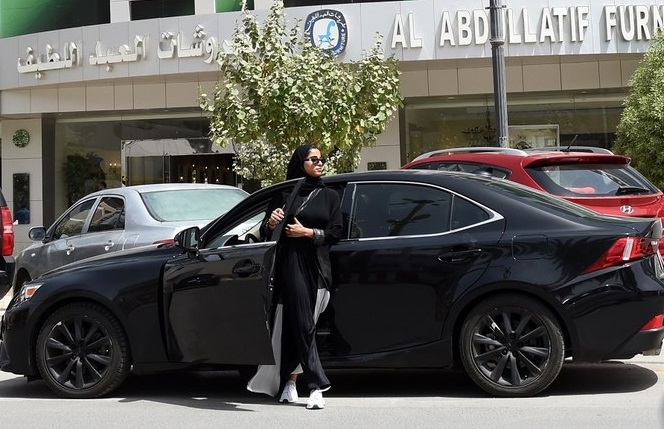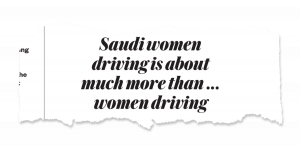- ARAB NEWS
- 04 Jul 2025

Mo Gannon
Summary:
On June 24, 2018, Saudi women took their place behind the wheel, driving on the Kingdom’s roads legally for the first time. The historic day came about as part of a series of reforms under Vision 2030, announced in 2016 by then-Deputy Crown Prince Mohammed bin Salman. It was followed by a royal decree on Sept. 26, 2017, lifting the ban on women driving.
The decision had a demonstrable effect on the daily lives of women and on the Kingdom’s economy. In 2020, it was one of the reforms that led to Saudi Arabia being recognized by the World Bank as the top reformer globally in the past year when it comes to female empowerment and gender equality.
DUBAI: This story could be called a tale of two countries. When I arrived in Jeddah from our Dubai office for my first visit to Saudi Arabia on June 20, 2018, I was not allowed to drive. And then, four days later, along with every other woman in the Kingdom, all of a sudden we could. Much like Cinderella in the fairy tale, our pumpkins turned into carriages at the stroke of midnight on June 24, 2018.
So much has changed since then that it seems like ancient history. The guardianship law, which required Saudi women to get a male guardian’s permission to travel, was rescinded in August last year, and foreign female travelers are no longer expected to wear abayas and headscarves. And in December, the Kingdom officially ended gender segregation in public places, although Saudi women and men had already begun to mingle.
This was all unthinkable at the time that the driving ban was lifted — the first major, visible sign that the Kingdom was serious about change. As my Saudi colleague Noor Nugali pointed out, it was a “mind-blowing” signal that it was headed “100 miles in the right direction.”
So let us reverse, if you will, to the time when the Kingdom was the last country in the world where women could not drive. Arriving on a humid morning at Jeddah’s airport, I stepped off the plane in my abaya with a sense of excitement tempered by fear at what I might encounter as a solo foreign woman in the Kingdom.
After a decade living in the UAE, I had heard stories from other women about their encounters with the Saudi religious police, so I wrapped my headscarf tightly and prepared for the worst.
Mistakenly joining the line for Umrah arrivals, I was approached by a customs officer who, after looking at my visa, asked me to have a seat while he sorted an issue by calling an Arabic speaker in our Jeddah newsroom. “This is it,” I thought. “I’m going to jail.” What happened next was a total surprise. He returned, offering me Arabic coffee and a chocolate heart before helping me through the gates.

“Of all the places I have filed my column from, I never thought one of the most significant would be the passenger seat of my company car … Because the driver sitting next to me was one of my female colleagues at Arab News — and one of the first women to legally take the wheel after the end of a decades-long ban.”
From a page column by Editor in Chief Faisal J. Abbas in our special issue, June 24, 2018
The driver sent to pick me up told me I did not have to wear a headscarf, so I let it go around my shoulders, already feeling more relaxed. He brought me to the Jeddah Hilton, with a lobby that looks like a “Star Trek” spaceship, and escalators that curl around like spiral staircases.
For the next few days, I made my trips to the Jeddah newsroom with Bakhsh, our ever-smiling company driver who insisted on carrying my bags, whenever he was available. But to those who claim the lifting of the driving ban was just a token gesture, I can tell you: It was anything but. Imagine getting through your day by relying on someone to pick you up at every point, then remember the freedom you felt when you got your license and the keys to your first car.
So when the clocks on our iPhones turned to 12:01 a.m. on June 24, it was not just a sign to start our engines. It was time for Saudi Arabia to leave this old way behind, and the unnecessary load that came with it.
At this time, I was already in the driver’s seat of our company car, wearing Saudi designer Moe Khoja’s driving jacket, embroidered with the date of this occasion. My boss Faisal J. Abbas, beside me in the passenger’s seat, had designated me to take him and my two female colleagues on this drive, because a Saudi woman in our newsroom had yet to get a license. It was not just a historic drive for me; for them, it was the first time they had been driven by a woman in the Kingdom.
The Ministry of Commerce and Investment announces that Saudi women do not need permission from a male guardian to start their own businesses.

The Ministry of Justice releases a circular to courts that would allow divorced women to automatically retain custody of their children.

The Council of Ministers approves a law making sexual harassment a crime.
Women drive for the first time on Saudi roads after a decades-long ban is lifted.

Women are allowed to travel freely without their guardians’ approval.

Off we drove that night in a big black SUV, rolling down our windows at stoplights and waving to surprised Saudis, who smiled and gave us their thumbs up. The real test was when we pulled up next to a police car at the next light. We waited in nervous silence, until the light turned green and we let go of our breaths, driving off without incident.
The next morning, as more Saudi women took to the roads, I approached the rental-car desk in my hotel lobby to ask about renting a car. The man told me it was not possible. “Oh yes it is,” I told him. “Haven’t you read the news?”
I showed him Arab News’ special issue that day, wrapped in Malika Favre’s illustration of a Saudi woman driving, which went on to become an iconic image of that day. Sadly, it did not help my appeal. He called his supervisor, who told me I needed a Saudi license.
Remarkably, after I wrote about this in Arab News, the chief operating officer of Budget Saudi Arabia contacted me to rectify the confusion. He invited me to visit their office on the Corniche, where I produced my international driver’s license and became the first foreign woman to rent a car in Saudi Arabia.
Much like Cinderella in the fairy tale, our pumpkins turned into carriages at the stroke of midnight on June 24, 2018.
Mo Gannon
As I climbed into the white Land Cruiser, people on the street stopped to take photos with their mobile phones. That night, when I took my ladies on a drive to Old Jeddah, we got the same reception from the crowded streets: Smiles and waves. And unlike most places in the world, male drivers courteously stopped to let us ahead of them in traffic.
We rolled down the windows, blasting the song Saudi singer Tamtam wrote for the occasion: “We know it’s our time… let go of past perceptions, tomorrow is mine. We got drive, pushing through the limits, we ride. We have dreams, and every day we’re making them real…”
I am glad we soaked up the celebrity attention while we had it, because as more Saudi women got their licenses, it has become commonplace to see women driving in the Kingdom. The initial objections raised to allowing women on the roads — that they would clog the streets with traffic or cause more accidents — now seem silly notions from a time long past.
Back at home, I often get asked what it is like to drive in the Kingdom. “Isn’t it scary?” people wonder. My answer to them now is: It is just like anywhere else. And that is exactly how it should be.